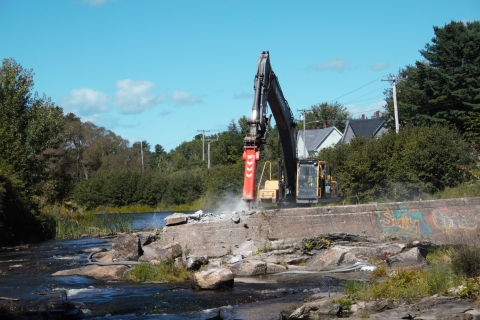On a quintessential mid-September day, officials and community members gathered on the banks of the Sabattus River in Lisbon, Maine, to bid farewell to two landmarks that had outlived their usefulness and usher in an era of improved public safety, fish passage fish passage
Fish passage is the ability of fish or other aquatic species to move freely throughout their life to find food, reproduce, and complete their natural migration cycles. Millions of barriers to fish passage across the country are fragmenting habitat and leading to species declines. The U.S. Fish and Wildlife Service's National Fish Passage Program is working to reconnect watersheds to benefit both wildlife and people.
Learn more about fish passage , and recreation.
Time to go
For more than 150 years, Upper Town Dam and Mill Remnant Dam blocked migratory fish from their spawning habitat in the Androscoggin watershed. More recently, they also contributed to flooding issues in the community. Built to power industry in the 19th century, they were liabilities in the 21st.
The U.S. Fish and Wildlife Service joined project partners, including Maine Department of Marine Resources, Atlantic Salmon Federation, and the Town of Lisbon, to highlight the start of the first fish passage project in the nation funded under the Bipartisan Infrastructure Law Bipartisan Infrastructure Law
The Bipartisan Infrastructure Law (BIL) is a once-in-a-generation investment in the nation’s infrastructure and economic competitiveness. We were directly appropriated $455 million over five years in BIL funds for programs related to the President’s America the Beautiful initiative.
Learn more about Bipartisan Infrastructure Law .
Passed in November 2021, the infrastructure law is a once-in-a-generation investment that includes $200 million for the Service’s National Fish Passage Program over the next five years. The program supports aquatic ecosystem restoration projects and restores free-flowing waters, enhancing fish migration and protecting communities from flooding.
The project received $350,000 from the infrastructure law. The Upper Town Dam removal was also supported by the National Fish and Wildlife Foundation through the National Coastal Resilience Fund.
Brighter days for people and wildlife
The Sabattus project will remove the two obsolete dams and restore adjacent riverbanks. In addition to improving habitat for fish and wildlife, the work will increase public safety and reduce flood risk for nearby communities. Residents will enjoy enhanced access to outdoor recreation.
Removing these dams, in combination with other restoration projects, will restore access to important spawning habitat in the Androscoggin watershed for Federally endangered Atlantic salmon, river herring, American eel, and other migratory fish. It will also improve aquatic habitat for other wildlife species.
The Maine Department of Marine Resources estimates that 500,000 alewife, a species of river herring, could return to the Sabattus River to spawn each year.
Studies have shown that each mile of river opened so fish can move freely can contribute more than $500,000 in social and economic benefits, such as recreational fishing and tourism.
In June 2012, a strong storm flooded roads and breached the Upper Mill Dam. A restored, resilient Sabattus River will collect stormwater and carry it away from the community to the Androscoggin. Without the dams, the risk of flooding both upstream and downstream is reduced.
During the ceremony, the iron gate that controlled flow through the Upper Town Dam was carefully removed for preservation. It will serve as a reminder of the river’s industrial days as the community moves into the future with a free-flowing Sabattus.





